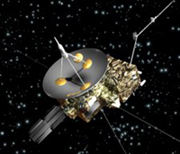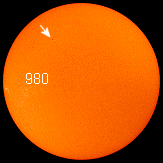
| Solar News --2008--
December 15, 2008 "Breathing" Cycles In Earth's Upper Atmosphere Tied To Solar Wind The thermosphere expands and contracts as it exchanges energy with the space environment, causing changes in thermosphere density. These "breathing" episodes are mainly caused by extreme ultraviolet radiation from the sun, and they can affect satellite flight paths. A new CU-Boulder study indicates that solar wind also triggers "breathing" cycles in the thermosphere by causing geomagnetic disturbances. News source:sciencedaily.com December 15, 2008  Hydrogen Atoms detected in 2006 X-9 Class Flare In 2006, NASA's STEREO spacecraft has detected pure hydrogen atoms in a stream of particles from one of the strongest flares of the past 30 years. Researchers now believe that some of the protons recapture an electron, forming intact hydrogen atoms, just before they escaped the Sun's atmosphere. Image Credit: NOAA, NASA. News source: science.nasa.gov November 21, 2008 Solar Wind Rips Up Martian Atmosphere Researchers have found new evidence that the atmosphere of Mars is being stripped away by solar wind. It's not a gently continuous erosion, but rather a ripping process in which chunks of Martian air detach themselves from the planet and tumble into deep space. This surprising mechanism helps explain why the Martian atmosphere is so thin. News source: science.nasa.gov November 7, 2008 Solar Cycle Update: Sun Shows Signs of Increasing Activity Five sunspot groups were observed in October, four of which belong to the new Solar Cycle 24. News source:science.nasa.gov November 3, 2008  Magnetic Portals Connect Earth to the Sun Flux Transfer Events (FTEs) form when the Earth's magnetic field presses against the Sun's magnetic field, on the dayside of Earth. The two fields briefly merge, forming a portal through which particles can flow. The portal takes the form of a magnetic cylinder about as wide as Earth. FTEs occur approximately every eight minutes, twice as common as anyone had ever imagined. Image Credit: NASA. News source: science.nasa.gov September 25, 2008 Solar Wind Pressure At 50-Year Low The average pressure of solar wind has dropped more than 20% since the mid-1990s, marking a 50-year low. This causes a weakening of the heliosphere, which may increase cosmic ray radiation in the solar system. See also: Spotless Sun: Blankest Year of the Space Age News source: www.sciencedaily.com, science.nasa.gov September 17, 2008  New Views of Polar Crown Prominences Japan's Hinode spacecraft, launched in 2006 on a mission to study the Sun, is beaming back movies of polar crown prominences. Solar astronomers have seen prominences like this before, but never so clearly. The new view is challenging some long-held ideas about these structures. Image Credit: NASA. News source: science.nasa.gov September 5, 2008 NASA to Explore "Secret Layer" of the Sun Researchers are preparing to launch an experimental telescope to look at the Sun's "transition region", thought to be the "birthplace" of space weather.
News source: science.nasa.gov August 19, 2008  Living With a Star What if you woke up one morning and found your whole planet had been swallowed by the atmosphere of a star? Don't laugh, it could happen, and NASA has a special program to deal with it. Image Credit: NASA. News source: science.nasa.gov Eclipse path (click to view map) Total Solar Eclipse on August 1, 2008 On Friday, August 01, a total eclipse of the Sun was observed in a narrow corridor that traverses half the Earth. The path of the Moon's shadow began in Canada and extended across northern Greenland, the Arctic, central Russia, Mongolia, and China where it ended at sunset. A partial eclipse was seen within the much broader path of the Moon's penumbral shadow, which includes northeastern North America, and most of Europe and Asia. Also see the main eclipse page Image Credit: NASA. Web source: science.nasa.gov July 11, 2008  The solar cycle, 1995-2015. What's Wrong with the Sun? (Nothing) The Sun is entering its 3rd year of eerie calm. Sunspots are rare and solar flares simply aren't happening. Is this "solar minimum" lasting longer than it should? A NASA scientist has examined centuries of sunspot data to find the answer. Image Credit: NASA. News source: science.nasa.gov June 10, 2008  NASA Plans to Visit the Sun NASA has a daring new mission on the drawing board: Solar Probe Plus, a spacecraft tough enough to visit the Sun itself Image Credit: NASA. News source: science.nasa.gov May 27, 2008 Cartwheel Coronal Mass Ejection Imagine a billion-ton cloud of gas launching itself off the surface of the Sun and then ... doing a cartwheel. That's exactly what happened on April 9, 2008, when a coronal mass ejection or "CME" pirouetted over the Sun's limb in full view of an international fleet of spacecraft. News source: science.nasa.gov April 18, 2008 SOHO confirms 36 year old solar theory Data from the VIRGO instrument on SOHO have been used to show that solar flares drive global oscillations in the Sun. This confirms a prediction made more than 30 years ago. The result has implications for our understanding of flares on the Sun and on solar-like stars. Solar flares set the Sun quaking Powerful starquakes ripple around the Sun in the wake of mighty solar flares that explode above its surface... News source: sci.esa.int March 28, 2008 Old Solar Cycle Returns Barely three months after forecasters announced the beginning of new Solar Cycle 24, old Solar Cycle 23 has returned. (Actually, it never left) News source: science.nasa.gov January 14, 2008  Ulysses Flyby of the Sun's North Pole (NASA Feature) Consider it a case of exquisite timing. Just last week, solar physicists announced the beginning of a new solar cycle and now, Jan. 14th, the Ulysses spacecraft is flying over a key region of solar activity--the Sun's North Pole. Image Credit: ESA January 4, 2008 
Solar Cycle 24 Begins (SpaceWeather.com) Solar physicists have been waiting for the appearance of a reversed-polarity sunspot to signal the start of the next solar cycle. The wait is over. A magnetically reversed, high-latitude sunspot emerged today. This marks the beginning of Solar Cycle 24 and the first step toward a new solar maximum. Intense solar activity won't begin right away. Solar cycles usually take a few years to build from solar minimum (where we are now) to Solar Max (expected in 2011 or 2012). It's a slow journey, but we're on our way! See also "Solar Cycle 24 Begins" (Science@NASA Feature) to learn more about the solar cycle and the potential consequences of increased solar activity. Image Credit: SOHO/MDI |